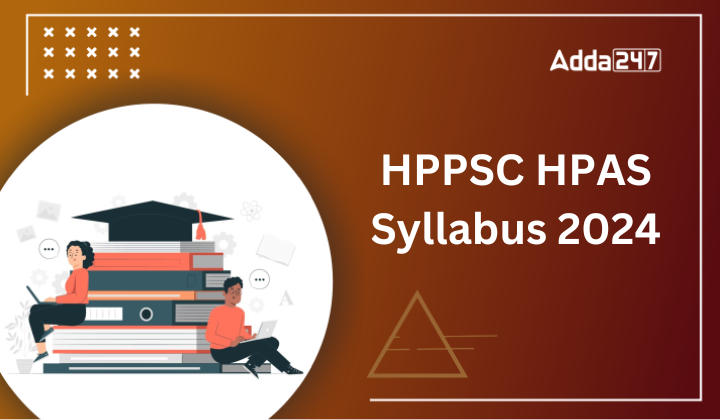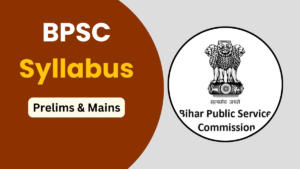For those preparing for the HPPSC HPAS exam, knowing the complete HPPSC HPAS Syllabus 2024 is the most important thing. The syllabus defines the topics and subjects covered in the exam, helping candidates understand how questions are structured and graded.
This knowledge is crucial for planning and focusing their preparation effectively. This article provides an opportunity for candidates to familiarize themselves with the HPPSC HPAS 2024 Syllabus , ensuring thorough preparation for the examination.
HPPSC HPAS Syllabus 2024
The syllabus covers a wide range of subjects including English, Hindi, General Studies, and elective subjects.
The HPPSC HPAS Prelims and Mains syllabus is essential for candidates who preparing for the HPPSC HPAS Exam 2024, offering detailed guidance and summarizing covered topics. A comprehensive understanding and mastery of the syllabus for English, Hindi, General Studies, and elective subjects are essential for effective preparation.
| HPPSC HPAS Syllabus 2024 Highlights |
| Exam Name |
HPPSC HPAS 2024 |
| Exam Conducting Body |
Himachal Pradesh Public Service Commission |
| Post Name |
HP Administrative Services and HP Police Services |
| Vacancy |
26 Post |
| Category |
Syllabus and Exam Pattern |
| Marking Scheme |
Prelims- 400 marks and Mains- 1100 marks |
| Job Location |
Himachal Pradesh |
| Official Website |
hppsc.hp.gov.in |
HPAS Syllabus 2024
It covers all the topics of HPPSC HPAS Prelims and Mains Examination 2024. Over here candidate will find out the prelims exam subjects syllabus as well as the mains examination syllabus for different subjects like English, Hindi, General Studies, and elective subjects, serving as essential resources for exam preparation.
By focusing on these specific areas, aspirants can adequately prepare for all three stages of the selection process. Starting your preparation according to the provided syllabus is key to achieving success in the HPPSC HPAS exam.
HPPSC HPAS Prelims Syllabus
Though the official syllabus will be released along with the HPPSC HPAS 2024, we are providing the syllabus that has been taken into consideration by HPPSC while conducting the recruitment exam in the previous years. Candidates are advised to go through the table given below to get an idea about the HPPSC HPAS Prelims Syllabus 2024.
| HPPSC HPAS Prelims Syllabus 2024 |
| Paper – I General Studies |
- History, geography, politics, art & culture and socio-economic development of Himachal Pradesh.
- Current events of national and international importance.
- History of India and Indian national movement.
- Indian and World Geography- Indian physical, social, and economic geography as well as of the world.
- Indian polity as well as governance which covers the constitution, political system, Panchayati Raj, Public Policy, and Rights Issues.
- Economic and social development which includes sustainable development poverty, inclusion, demographics, and social sector initiatives.
- Issues on environmental ecology, bio-diversity, and climate change.
- General Science.
|
| Paper-II Aptitude Test |
- Comprehension
- Interpersonal skills, including communication skills
- Logical reasoning and analytical ability
- Ability of decision-making and problem-solving along with general mental ability, basic numeracy, numbers and their relations, orders of magnitude etc. (Class X level)
- Data interpretation (charts, graphs, tables, data sufficiency etc. – Class X level)
- English Language comprehension skills (Class X level)
|
HPSC HPAS Exam Pattern for Prelims
The HPPSC HPAS Prelims examination consists of two objective-type papers comprising multiple-choice questions, totaling a maximum of 400 marks. It serves as a screening test exclusively. The scores attained in the Preliminary Examination do not contribute to the final merit list. The final merit list is prepared based on the performance in the Mains and Interview stages.
| HPPSC HPAS Prelims Exam Pattern 2024 |
| Paper |
Subject |
Marks |
Questions |
Time Duration |
| I |
General Studies |
200 |
100 |
2 hours |
| II |
General Studies (Aptitude Test) |
200 |
100 |
2 hours |
|
Total |
400 |
– |
– |
HPPSC HPAS Mains Syllabus
A thorough comprehension of the syllabus is crucial for candidates preparing for government recruitment examinations. It aids in devising an effective preparation strategy. Here is the detailed syllabus for the HPAS Mains Exam, as outlined by the Himachal Pradesh Public Service Commission:
| HPPSC HPAS Mains Syllabus |
| English Paper-100 Marks |
| English Grammar – (20 Marks) |
| Usage and Vocabulary – (20 Marks) |
| English Composition Letter / Application / Report / Note writing – (20 Marks) |
| Comprehension of unseen passages – (20 Marks) |
| Precis Writing – (20 Marks) |
| Hindi Paper in Devnagri Script -100 MARKS |
| Translation of an English passage into Hindi. |
| Translation of Hindi passage into English. |
| Explanation of Hindi passage in Prose and Poetry in the same language. |
| Composition (Idioms, corrections etc.) |
| Essay Paper-100 MARKS |
| Current affairs |
| Socio-political issues |
| Socio-economic issues |
| Aspects of culture and history |
| Reflective topics to test candidates’ understanding and expression in English or Hindi language |
HPPSC HPAS Exam Pattern for Mains
HPPSC HPAS Mains exam will be descriptive. Apart from language papers, the optional plays an important part in shaping the course of the result of a candidate. The pattern of the HPPSC HPAS Mains exam is given below.
| HPPSC HPAS Mains Exam Pattern 2024 |
| General Studies |
Subject |
Maximum Marks |
| Paper I |
English |
100 |
| Paper II |
Hindi |
100 |
| Paper III |
Essay |
100 |
| Paper IV |
General Studies-I |
200 |
| Paper V |
General Studies-II |
200 |
| Paper VI |
General Studies-III |
200 |
| Paper VII |
Optional Paper I |
100 |
| Paper VIII |
Optional Paper II |
100 |
HPPSC HPAS Syllabus for GS-I & GS-II
| General Studies I -200 MARKS |
|
|
Unit One
- Historical perspective of Indian Cultural heritage.
- Literature and Art forms from ancient times to 1947.
- Modern Indian history from mid–18th century till 1980.
- Freedom Struggle covers various stages and the role of eminent persons from different parts of India.
- The Industrial Revolution was supplemented with the emergence of Capitalism.
- World Wars.
- Concepts of Decolonization, Nationalism and Socialism, Globalization and Concept of Modernity.
- Emergence and growth of early medieval states in HP: Kangra, Kullu and Chamba.
- Hill States and their relations with the Mughals and the Sikhs.
- Gorkha invasion and consequences, Treaty of Sugauli.
- Political and Administrative structure under the Colonial power.
- Grants, Sanads and territorial aggression.
- Socio-economic conditions under the colonial period with special reference to the social practices of Beth, Begar and Reet.
- Establishment of British Cantonments.
- National Movement with special reference to Praja Mandal movements in Himachal Pradesh, 1848-1948.
- Five-Year Plans and Vision for the Hill State.
- Survey of artistic and cultural Heritage (Temples, Buddhist Monasteries and Paintings) relevant to the State of Himachal Pradesh.
- Topics relevant to the State of Himachal Pradesh.
|
|
|
Unit Two
- Introduction to Disasters and classifications including natural and man-made disasters.
- Social and Environmental impacts of disasters.
- Disaster profile of the country, National and state policies, Plans and institutional mechanisms in the country.
- Approaches to Disaster Risk Reductions.
- Disaster management models.
- Roles and responsibilities of stakeholders including community, concept of first responders.
- Interrelationship of disaster and development.
- Disaster management in India including Disaster Management Act 2005.
- India as a unit of Geographical Study.
- Aspects of the Physical Geography of India.
- Human Aspects – Population distribution, Urban Population, Internal Migration.
- Language and Literacy, Villages and Towns in India.
- Settlements, Industry and Transport.
- Geography of Himachal Pradesh: Relief, Drainage, Vegetation cover and types.
- Climate and climatic zones in Himachal Pradesh.
- Geographical Regions of Himachal Pradesh (Shiwalik, Doons and Low Valleys, Outer Valleys of Sub Himalaya, Mid Hill Tracts of High Himalaya, High hills and Valleys and Inner Zones).
- Human Aspects covering Quantitative, Qualitative and Temporal characteristics of Population, Urbanization pattern.
- Policies related to Forest, Industrial and Tourism Policies, Growth of Industrial areas and types of Industries in Himachal, Employment generation and potential, Scope of future Industrialization, Hazard Vulnerability and Risk Profile of Himachal Pradesh.
|
|
| General Studies II- 200 MARKS |
|
Unit One
- Constitution of India covering Historical underpinning, evolution, salient features.
- Significant provisions including Fundamental Rights, Directive Principles of State Policy, Fundamental Duties.
- Amending process and important Constitutional Amendments and theory of basic structure.
- Parliament and State legislatures and functioning of the Union and State Executive and the Judiciary.
- Functions and responsibilities of Union and States.
- Issues and challenges pertaining to the federal structure, devolution of powers and finances up-to local level and challenges therein.
- Salient features of the Representation of People’s Act.
- Appointments to various constitutional posts, powers, functions and responsibilities of various constitutional bodies in India.
- Reorganization and politics of statehood.
- Development of political parties, major Political parties and their support base and performance in the Assembly and Parliamentary elections in Himachal Pradesh.
- Politics of sub-regionalism and pressure groups in the State.
- Structure, organization and functioning of Statutory, Regulatory and various Quasi-Judicial bodies in Himachal Pradesh.
|
|
Unit Two
- Institutional framework development in various sectors in India.
- Governance, Good governance, Citizen Charters, effective public service delivery, transparency, accountability and ethics in governance in India.
- District Administration: The changing role of Deputy Commissioner.
- Local self-government in urban and rural areas in India.
- Role of Non-Government Organizations (NGOs).
- Self Help Groups (SHGs) and Civil Society in Governance in India.
- Bodies constituted Policies, Programmes and Schemes for the welfare of Scheduled Castes, Scheduled Tribes, Women, Minorities, Backward classes, Differently-abled persons, and children in India.
- Issues relating to the quality of life covering livelihood, poverty, hunger, disease and social inclusiveness.
- Governance in Himachal Pradesh.
- The Himachal Pradesh Public Service Guarantee Act 2011.
- Right to Information Act, 2005 and rules made thereunder by the Himachal Pradesh Government.
- Administrative reforms for effective public service delivery in Himachal Pradesh.
- Implementation of 73rd& 74th Constitutional amendments in Himachal Pradesh.
- Issues and Challenges, Programmes and Policies for the Welfare of differently-abled Persons, women and children in Himachal Pradesh.
|
|
Unit Three
- Bilateral, Regional and Global groupings and agreements involving India and affecting India’s interests.
- India’s Look East policy.
- India’s relations with the United States of America (U.S.A.), Russia, China, Pakistan, Bangladesh, Sri Lanka, Afghanistan, Nepal, Maldives and Middle Eastern countries.
- Effects of the policies of developed and developing countries on India’s interest, Indian Diaspora.
- Important international Institutions.
- Cybercrime and drug menace & mechanism to detect and control it in Himachal Pradesh.
- Enactments made by Himachal Pradesh Government to protect and promote the interests of agrarian society.
- Various policies framed by the Government of Himachal Pradesh for the socioeconomic development of Scheduled Castes and Scheduled Tribes of the State.
- Tribal welfare administration, Tribal sub-plan and Single line administration in Himachal Pradesh.
|
| General Studies III |
| Unit One
Sub Unit–1: Characteristics of Indian Economy
- Demographic Profile, Demographic Dividend and Population Policy.
- Sectoral Composition for Contribution to Gross Domestic Product (GDP) and Employment.
- Poverty and Inequality, Unemployment, Inflation in India.
- Industrial Growth in India.
- Regulatory framework for money and banking: Reserve Bank of India (RBI), Commercial banks and Regional Rural Banks.
- Monetary policy, Foreign exchange, Balance of Payment Scenario.
- Foreign Trade: Policy, Composition and Direction, Impact of Liberalization / Privatization and Globalization.
Sub Unit 2: Economic Planning in India
- Five Year Plans: strategies and outcomes, Public / Private / Joint Sectors.
- Fiscal Policy, Fiscal Responsibility and Budget Management Act, 2003, Debt and Investment in India: Current Status, Growth and Development experience including Natural Resource Management.
- Sustainable development and Inclusive growth.
- Measurement of economic development: Physical Quality of Life Index (PQLI), Millennium Development Goals, Human Development Index (HDI) / Gender Development Index (GDI) / Gender Empowerment Measure (GEM).
- Latest / Current Development Schemes / Initiatives / Institutional Changes.
Sub Unit 3: Economy of Himachal Pradesh
- Demographic profile and Human resource, Sectoral distribution of Gross State Domestic Product (GSDP).
- Diversification in Agriculture and allied activities, Land tenure and size of land holdings.
- Industrialization in the state.
- Skilled / Unskilled labour.
- Revenue generation with special reference to hydro potential, tourism, flora and fauna.
- Cottage and Small Scale Industries.
- Tax base, Pros and Cons of Special Category status.
- Appraisal of Education, Health, Physical and Financial Infrastructure Development.
|
| Unit Two
Sub Unit 1: Applications of Space Technology
- Important missions and programmes of the Department of Space and Indian Space Research Organization.
- Historical evolution of the Indian Space programme.
- Remote Sensing and Communication satellites.
Sub Unit 2: Developments in Energy Sectors
- Hydropower, non-conventional sources of energy and nuclear energy including policies, programmes, and research base in the country.
- Role of energy in sustainable development.
Sub Unit 3: Modern and Emerging Technologies in Himachal Pradesh
- Biotechnology policy, research, vision, scope and applications for developing horticulture, medicinal and aromatic plant resources of the State.
- IT policy of Himachal Pradesh and its role in governance.
- State Biodiversity Strategy and Action Plan.
- Relevance and role of Intellectual Property Rights, Geographical Indications and Traditional wisdom and knowledge in the sustainable development of the State.
|
|
Sub Unit 1: Environment Protection and Climate Change
- Issues, concerns, policies, programmes, conventions, treaties and missions aimed at environment protection, and dealing with the problem of climate change.
- State of environment reports. Environment protection and pollution control Act and rules.
- Environment Impact Assessment.
- National Action Plans on Climate Change.
- Himalayan ecology, biosphere reserve, Science and economics of climate change.
- Social and ethical issues in the use of Biotechnology.
Sub Unit 2: Developments in Agriculture and Horticulture
- National mission for sustainable agriculture, mission for integrated development of horticulture.
- Concept of organic farming, seed certification, rainwater harvesting, techniques of irrigation and soil conservations and soil health cards.
Sub Unit 3: Tourism Policy and Initiatives in Himachal Pradesh
- Types of tourism: religious, adventure, heritage, Important tourist destinations in Himachal Pradesh.
- Social, Economic and Cultural Implications of Tourism.
- Concept of Eco-Tourism and green tourism and their role in sustainable development of the State.
- Environmental concerns of the tourism industry, both positive and negative effects including climate change about Himachal Pradesh.
|
Optional Subjects in the HPPSC HPAS Exam
Apart from the compulsory papers, there will be two optional papers in the HPPSC exam. There are 31 optional subjects out of which candidates have to choose their subject. The optional subjects for the HPPSC HPAS Exam 2024 are as follows:
| List of Optional Subjects in HPPSC HPAS Mains Exam |
| Indian History |
Agriculture |
| Political Science and International Relations |
Mechanical Engineering |
| Mathematics |
Electrical Engineering |
| Statistics |
Civil Engineering |
| Economics |
Hindi |
| Commerce and Accountancy |
Sanskrit |
| Chemistry |
Urdu |
| Botany |
English Literature |
| Zoology |
Psychology |
| Philosophy |
Geology |
| Law |
Physics |
| Sociology |
Animal Husbandry and veterinary Science |
| Public Administration |
Anthropology |
| Management |
Forestry |
| Geography |
Horticulture |
| Medical Sciences |
|
HPPSC HPAS Interview 2024
For HPPSC HPAS recruitment, three times the number of vacancies will be called for interview based on written exam results. In case of a tie in minimum qualifying marks, all tied candidates will be interviewed. The final ranking and allocation of services/posts will be based on the main exam and interview scores.
Sharing is caring!



 APSC Syllabus 2025, Download Prelims And...
APSC Syllabus 2025, Download Prelims And...
 Punjab PCS Syllabus 2025, New Prelims an...
Punjab PCS Syllabus 2025, New Prelims an...
 BPSC Syllabus 2025 and Exam Pattern For ...
BPSC Syllabus 2025 and Exam Pattern For ...




